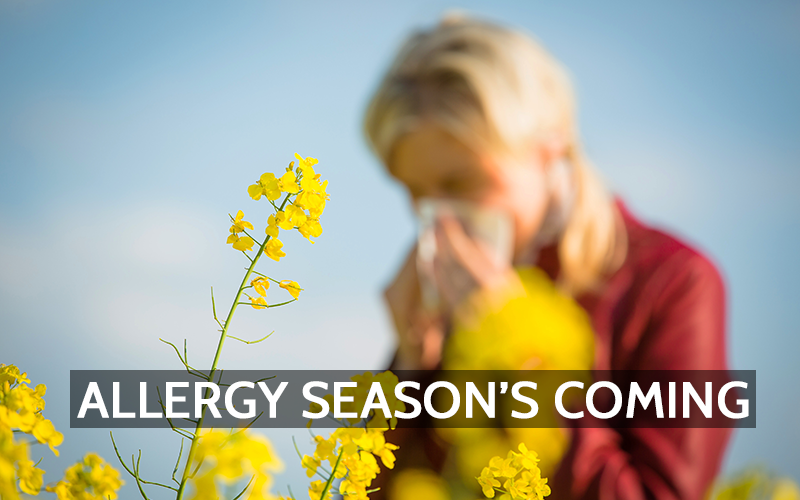Seasonal allergies, commonly known as hay fever or allergic rhinitis, affect millions worldwide, causing symptoms like sneezing, itchy eyes, and nasal congestion. Understanding the sources of allergens, the immune system’s response, and effective mitigation strategies can help manage these seasonal discomforts.
Sources of Seasonal Allergens
Seasonal allergens primarily originate from pollen released by trees, grasses, and weeds, as well as mold spores. The presence of these allergens varies throughout the year:
-
Tree Pollen: In many regions, tree pollen is prevalent in early spring, with species like oak, maple, and birch releasing pollen that can trigger allergic reactions.
-
Grass Pollen: Late spring to early summer marks the peak of grass pollen season. Grasses such as Timothy, ryegrass, and Kentucky bluegrass are common culprits
-
Weed Pollen: Weed pollens, particularly from ragweed, become prominent in late summer and fall, often causing severe allergic responses.
-
Mold Spores: Mold thrives in warm, humid conditions and can be found both indoors and outdoors. Outdoor mold spores increase in number during the fall, especially in areas with decaying leaves.
Pollen counts tend to be highest during the morning hours and on dry, windy days, as these conditions facilitate the dispersal of pollen grains.
The Immune System’s Response to Allergens
Allergic reactions occur when the immune system identifies a typically harmless substance as a threat. This misidentification leads to a series of immune responses:
-
Sensitization: Upon first exposure to an allergen, the immune system produces Immunoglobulin E (IgE) antibodies specific to that substance.
-
Mast Cell Activation: These IgE antibodies attach to mast cells, which are abundant in tissues like the skin, lungs, and nasal passages.
-
Release of Histamines: Subsequent exposure to the same allergen causes these mast cells to release histamines and other chemicals, leading to inflammation and common allergy symptoms such as sneezing, itching, and congestion.
This hypersensitive response is often influenced by genetic and environmental factors, with a family history of allergies increasing the likelihood of developing similar reactions.
Strategies to Mitigate Allergy Symptoms
Managing seasonal allergies involves a combination of indoor environment controls, medications, and lifestyle adjustments:
-
Monitor Pollen Counts: Stay informed about local pollen levels through weather reports or dedicated apps. On days with high pollen counts, limit outdoor activities, especially during peak morning hours.
-
Maintain Indoor Air Quality: Use high-efficiency particulate air (HEPA) filters in your home to reduce indoor allergens. Regularly clean and vacuum to minimize dust and mold accumulation.
-
Personal Hygiene: Shower and change clothing after spending time outdoors to remove pollen that may have settled on your body and garments.
-
Medications: Over-the-counter antihistamines and nasal corticosteroid sprays can alleviate symptoms. However, it’s essential to consult with a healthcare provider to determine the most appropriate medication and be aware of potential side effects.
-
Allergen Immunotherapy: For persistent and severe allergies, immunotherapy (allergy shots) may be considered. This treatment involves gradual exposure to the allergen to build tolerance over time.
-
Protective Measures: Wearing sunglasses can shield your eyes from pollen, and applying a small amount of petroleum jelly around the nostrils may help trap pollen particles.
By understanding the sources of allergens and the body’s response, individuals can take proactive steps to reduce exposure and manage symptoms effectively, enhancing their quality of life during allergy seasons.
Related Article:
Urban Planning Strategies for Tackling Air Pollution
References:
- https://acaai.org/allergies/allergic-conditions/seasonal-allergies/
- https://www.bvhealthsystem.org/expert-health-articles/seasonal-allergies-a-month-by-month-guide
- https://www.zyrtec.com/allergy-guide/outdoors/best-times-low-pollen-count
- https://www.hopkinsmedicine.org/health/conditions-and-diseases/allergies-and-the-immune-system
- https://www.mayoclinic.org/diseases-conditions/allergies/symptoms-causes/syc-20351497
- https://en.wikipedia.org/wiki/Allergen_immunotherapy


